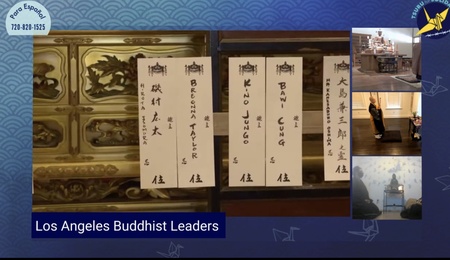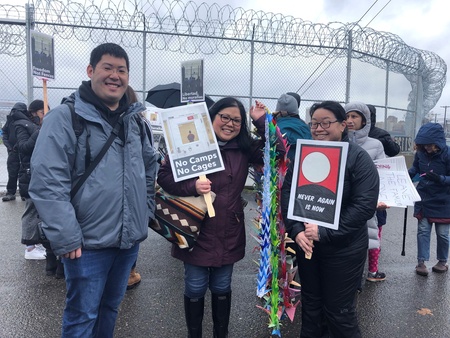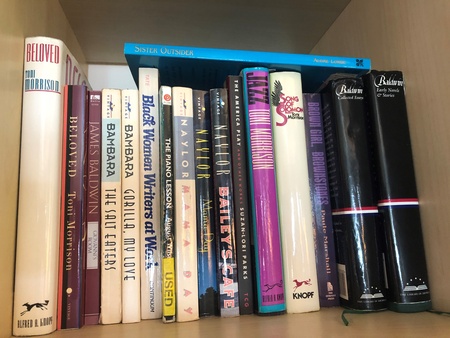“I recognized that the heartbeat, historically, of racism, has been denial.”
— Ibram Kendi
Brokenness.
There are times to write normality and there are times to write brokenness. Feeling the need for something as it was—“normal”— the essay I wanted to write used a straightforward reporting style, journalism, objectivity, neutrality. This style is what we’re accustomed to as “normal.” It’s mid-2020. These times are both normal and broken, and some ways were always broken. This essay objected to the idea of objectivity and neutrality in writing. This essay insisted that it be written instead.
Here are some of my keywords for being Nikkei in a moment of racial reckoning.
Choice.
It’s 2020. I am registering my daughter for an online summer program. Though the program usually serves Black and Latinx kids in Florida, I ask if my daughter would still be qualified for the program. They welcome her “with open arms.” The form asks my racial background, and then my daughter’s. The choices are: A) Black; B) White; C) Biracial. I choose C, and explain in the Comments section. “I am Asian American.”
Hierarchy.
In third grade, my White friend Celeste throws an arm around my shoulder. “At least you’re not Mexican,” she declares, proudly.
Horizontal.
In seventh grade I am walking alone over to my locker after school. On my way, I see two White boys are sitting near a wall, as if waiting for me in an alley. One of them stretches his eyelids horizontal with his fingers. “Ching Chong, Ching Chong,” he laughs. I flip them off. I keep walking.
Mistaken.
My Filipina grandmother, wife of a Filipino soldier in the US Army, only spoke briefly about coming to the United States. “I was mistaken for being Black,” she says. Like other immigrants, she learned quickly that distancing herself from Blackness granted her some mobility. I wonder if she was able to drink from the White drinking fountains instead. She’s talking about a family friend: “He’s from Puerto Rico?” She lowers her voice, whispers: “I think he’s part Black.”
Silence.
In 2001 I was in Knoxville, Tennessee—one of my first times as a West Coast Asian American woman in the South. I was a graduate student presenting a paper at the MELUS conference, an academic gathering devoted to studying the multi-ethnic literatures of the United States. I always tried to escape conferences and visit cities, so I decided to visit the Knoxville Museum, where an exhibit of African American quilts was on display. I paid for my ticket, and asked if I needed to check my backpack. The old bearded White man in his red museum uniform smiled, and handed me my claim ticket: “No tickee, no laundry,” he smiled. Unfortunately—and I regret this still—I was shocked into silence. The exhibit was called Roots of Racism: Ignorance and Fear.
Lynching.
In graduate school—and not until then—I learn about the courage of Ida B. Wells. I learn something about what lynching really means, just how much intentional brutality it involves. It doesn’t just mean images of mutilated Black bodies. It also means the White women and children eager to attend the spectacle as if for a picnic. As a nation, we continue to see and not see lynchings of Black men and Black women. After hearing about the latest incidents in 2020, my youngest daughter says that she can’t stop thinking about the man who can’t breathe.
AntiBlackness.
In graduate school—and not until then— I begin to unlearn some of the antiBlack racism I have internalized, just by growing up in America. Toni Morrison’s short story Recitatif insists that the reader wrestle with the social construction of race, based on physical and cultural stereotypes, cultural insider knowledge, historical positionality. I learn that my antiBlackness relies on phenotype, classist, racist ideas. These ideas are hardly better than the phrenologists who used to read character based on skull shape. I’m embarrassed, horrified even, but I don’t stay there. I let the discomfort move me into learning more, and the learning becomes transformative. I’m still learning.
Challenge.
In graduate school—and not until then—I learn about African American studies, African American culture, African American history. The more I learn about these subjects, the more I know how much I have to unlearn. I learn how much I owe to African American teachings and practices of solidarity, coalition. I learn from the words and the lives of Audre Lorde, Bernice Reagon, bell hooks, Toni Morrison, Toni Cade Bambara, Angela Davis.
I reread Audre Lorde’s essay “Learning from the 60s” for comfort and challenge: “You do not have to be me in order for us to fight alongside each other. I do not have to be you to recognize that our wars are the same. What we must do is commit ourselves to some future that can include each other and to work toward that future with the particular strength of our individual identities.”
Reparations.
At a conference, I hear legal scholar Eric Yamamoto speak about the legal impact of reparations for Japanese Americans and the connections to reparations for African Americans. “I suggested,” Yamamoto wrote in a 1998 paper for the Boston Law Review, “that the key to the legacy of redress was how Japanese Americans acted when faced with continuing racial subordination of African Americans, Native Americans, Native Hawaiians, Latinas/os and Asian Americans. Would we draw upon the lessons of the reparations movement and work to end all forms of societal oppression, or would we close up shop because we got ours?”
Reparations means one thing for Japanese Americans, another for African Americans. It is a milestone for Japanese Americans, a unfulfilled centuries-long struggle for African Americans.
Tsuru.
In February 2018 a call goes out to fold 10,000 cranes to bring to Dilley, Texas and Fort Sill, Oklahoma. With the help of an educator friend, I organize two fold-ins at one of the high schools. I talk about the direct connections between what my Nikkei family experienced: family separation and indefinite detention.

In 2020, I continue to learn from the Tsuru for Solidarity organizers, including Satsuki Ina, Stan Shikuma, and Mike Ishii. Together with many others they organized a national online conference and pivoted quickly from their original opening program to one which focused on Black Lives Matter and other organizers of color across the country. I continue to learn from groups like Japanese Americans for Justice, which organized and televised a direct action as part of the Tsuru for Solidarity conference.
As anyone who has folded a crane will tell you, making tsuru is not easy. It takes a lot of patience and practice. Mistakes will be made. I am probably making mistakes even now, as I learn to write and to take action. But I am learning.
Abolition.
In February 2020 I am at the Northwest Detention Center in Tacoma for an unforgettable Day of Remembrance. I am hearing survivors of the camps and their descendants speak for prison abolition. “We [in Tsuru for Solidarity] are members of the Detention Action Network,” declares Mike Ishii, one of the organizers of the protest, to cheers from the mostly Nikkei crowd. I’m not sure if I have ever heard anyone Nikkei working on prison abolition before, and while I don’t claim to know the whole Nikkei community and its history, it gives me pause. I am the direct descendants of people imprisoned in American concentration camps. Why had I not thought about prison abolition as a “Nikkei cause” before?

Solidarity.
When I say “Asian American,” it is as a bridge, and as a claiming, and as an act of solidarity across a number of ethnic groups. As a Filipina Nikkei, it is a term that helps me claim all of my heritage. I read Sun Yeon Choimorrow’s words about working in solidarity, not allyship. “We will be able to show solidarity without shame or guilt, themes that I often hear from AAPI activists when we talk about how our own community is grappling with anti-Blackness.When we deeply understand our own oppression and its source, we are able to say “Black Lives Matter” without feeling the scarcity that somehow our communities’ concerns and needs are being made invisible.”
I continue to learn from Carl Takei, attorney for the ACLU, in his recent article for the Nichibei Weekly: “A Call for Solidarity With Black-Led Fights For Liberation.” “As Japanese Americans living in this historical moment,” he says, “we have a choice: We can stand quietly on the sidelines — as so many other communities did when we were targeted during World War II. Or, we can join in solidarity with these Black-led calls for action.”
I think about the questions to ask, as Hyejin Shim asked in her excellent 2017 essay “On the Limits and Effects of Asian American Allyship”: “What are the legacies we’ve inherited, which ones will we choose to protect, and which will we dismantle?”
Ongaeshi.
It is 2020. I write in praise of Black Lives, knowing that as a Nikkei, an Asian American, an American, I owe them so much. There are the larger legacies: the laws which African Americans have fought for have also directly affected my life as an American citizen. There are the personal legacies to the Black women in my life. My writer mentor friends here in Tacoma: Renee Simms and Rosalind Bell. My graduate school advisor, Johnnella Butler. The subject of my first book, who chose me to be her biographer: Senator Rosa Franklin. I hope that reckoning includes a full recognition of the debt of gratitude, the ongaeshi, that we can repay to Black Lives.
© 2020 Tamiko Nimura






